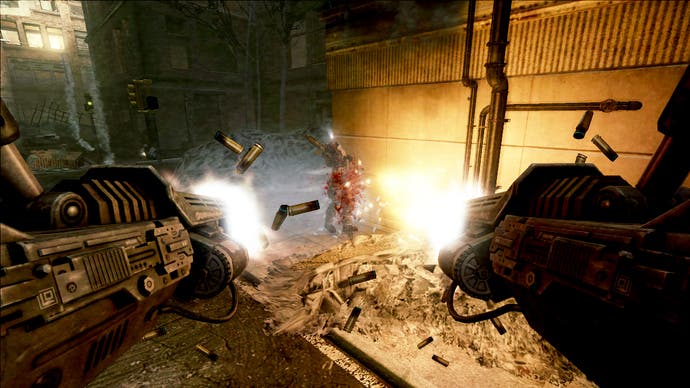F.E.A.R. 2: Project Origin
It's rude to Point Man.
The last time we saw Project Origin was in Monolith's Seattle headquarters early last year. What was on display then was two scenes from very different levels. The first showed you fighting against Abominations - Armacham's failed attempts at creating a psychic army. They couldn't stand up straight, but what they lacked in spinal integrity they made up for in the ability to grease around the walls and pop up for a quick nibble on your face. They could flip themselves up the walls like over-perky pancakes, and fold over themselves in a slightly nauseating and undignified display. It was righteously grim.
The other scene we played through was from a level in which you control a mech. It was perfectly justifiable in terms of storyline and canon - Armacham is one of the megacorporations from Monolith's well-loved mech fighter Shogo - but thundering around like an invulnerable clockwork bastard is the mathematical opposite of terrifying. More on that later, though.
Since then, the buyback of the F.E.A.R. name from Blivendivision has relegated the fan-suggested name of Project Origin to a subtitle, and those two isolated patches of action have been stitched together into a series of complete levels on display at a central London location. A location, it turns out, that is more known for its high-end sex parties, so out of Victorian prudishness we decline to rub our open-mouthed face against the walls and carpet.
This action in FEAR 2 starts, as you already know, half an hour before the end of the first game. Over by Alma's vault, Point Man (the first game's hero) is about to set off the apocalyptic explosion that frees her. This time you're playing Michael Beckett, a man who has - slightly unshockingly - latent psychic powers. The opening sequence is his hallucinatory and interactive flash-forward to the blood skies and unnaturally fast clouds of Alma's enraged release. In good time, and in keeping with the story's internal logic, we're assured, Beckett will develop his own time-bending skills to match Point Man's bullet time. The sky, the music box, and the lonely recurring image of a swing hanging from a tree is a re-introduction to the themes of lost innocence and fury that make up Alma's existence.

You'll still be fighting the Replica - Paxton Fettel may have eaten his last brain, and controlled his last drone soldier, but the psychic explosion of Alma's release activated the remaining sleeper units, who've reverted to their basic tactical military training. They're left without a psychic commander. We ask Dave Matthews, the game's Primary Art Lead, whether Alma might eventually fill that role, and he declines to answer. Matthews is well aware that the little-girl schtick was never original, and with eerie wee ladies popping up everywhere, he knows it was time to move on. Alma is physically there, now - so you'll see her as she is.
"In FEAR we explored the little girl, and how she interacted with Point Man. She was always at a distance, she led him through, and established the mood in a way that dovetailed with Japanese horror. Now she's out, after 16, 17 years in that vault, with her psyche still dreaming and hating, she's now completely toxic. To the point where she'll melt the flesh off of people. We couldn't just keep that child-like feel; she's getting closer to you, and it's never a good thing when she's touching you, or other people." The fleshing out of Alma as a character - if done well - could make Project Origin very satisfying to returning fans.
Monolith is selling the fact that this is a different style of game, with homages to different kinds of horror. Nightwatch and Daywatch are bigger influences now, as is the more personal slasher High Tension. Even cringe-porn flick Saw is an influence - and this is an example Matthews confesses to using too often, and he's keen to point out which element he's cherry-picking. "It's that response that happens in your body when you realise you're going to have to do something horrible, or something much worse is going to happen".









